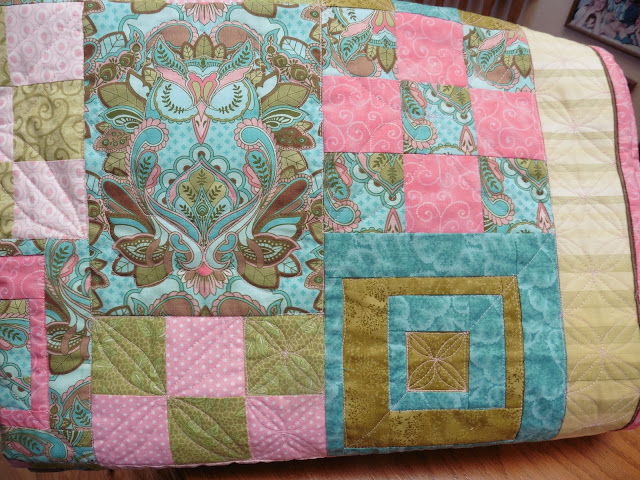This quilt for my granddaughter was inspired by three things:
- a fabric in my stash I loved, Moda's Full Moon Owls by Tula Pink,
- a pattern by Quilter's Dream I have been hankering to try, Square Root of Nine, and
- a desire to expand my FMQ bravery with a stitching path from Angela Walters book Shape by Shape.
Previous posts discussed the color selections, block placements, and border. What was left was the layering, quilting, and binding. For the FMQ I chose an Angela Walters quilting suggestion for squares, a four petaled pattern based on two diagonals within the square. I drew it below on a plastic sheet protector with a same block inserted inside.
It shows up better on some blocks rather than others depending on the fabrics, but it fills the space nicely.
For the square within a square blocks I wanted to accentuated the offset diagonal nature and so only did a four petal pattern in the very center. I intentionally quilted down only one of the diagonals (not both) to add some interest but I did stitch in the ditch around each square. My original idea was to add loops along the diagonal but they looked more like a chain link fence rather than flower petal or leaf and were distracting so I omitted them in favor of a simpler approach.
I am glad I am getting enough braver to quilt in a non-matching thread color. It shows up so much better, adding visual interest as well as texture.
On the quilt top I mixed it up a bit and added the four lobed motif in different sizes throughout. This is my overall plan. I printed a photo of the assembled top and drew my proposed path on it. Note where there was not a complete nine patch I chose to break it up into a four patch and two singletons. This four lobe pattern scales well and easily.
I did the lobes free hand but I did use a ruler on my Handi-Quilter sit-down to get the diagonals straight and to help stitch in the ditch neatly.
I repeated the four lobe pattern in the border, keeping it the scale of three motifs to one block. For the square in a square blocks that did not have the natural seaming dividing it in thirds, I marked a piece of masking tape, using as a guide. It is low tack tape and I just peeled it and moved it to where I needed it. I do not mark my quilt tops, both because I am lazy and also because I fear I could be unsuccessful in removing the marking medium.
Having a border the same width as a third of a block helping in quilting around the corners. There were no cornerstone problems needing adjusting or fudging.
The motif blended very well from within the quilt top to along the borders
The following photo illustrates the six quilting regions, clockwise from top left.
- I sort of "winged" it on the owl blocks, pretty much echoing the owl's shape and the leaves surrounding. I was considering doing "feathers" but decided I wanted the owls to be puffier rather than flattened by excessive stitching.
- Next is a large four lobed motif on a nine-patch block.
- The border has a series of the motif lined up and scaled to one third the dimension of a block.
- The two-tone magic binding has a stitching in the ditch along the chocolate accent flange.
- A square in a square block has a diagonal, stitch in the ditch around the squares and a single small central motif.
- Two-thirds of a nine-patch block has a four patch medium size motif and two small individual motifs.
As the final touch I added labels to the quilt back. On the left is the quilt name
Nestling Owls, and on the right, my initial and the year. I intentionally chose
Nestling Owls not
Nesting Owls because in my mind it conjures up images of cuddling.
Holding the quilt outdoors give a fair overall display, but colors are a bit muted in the shadows. Sunlight photos looked washed out. I keep gaining a growing appreciation for the photographers out there who can capture the essences of a quilt. Can you find the eight owls camouflaged in this quilt? I hope my granddaughter will enjoy looking for them.
Hanging the quilt indoors gives a bit more shadowed view that reveals the stitching. Yup. There are still eight owls there. Perhaps they are easier to spot now. Once you spot them will they be "spotted owls"?
Groan...
Without seeing the stitching detail, the back side of the quilt looks quite flat and frankly, a tad boring, even though I do
love this paisley-esque fabric.
Photographing in the sun at an angle show up more of the stitching and lends more interest.
I have washed it twice before gifting, and it did soften. I use 100% bamboo batting because I like its drape. Too much quilting makes for a quilt like flexible cardboard.
Nestling Owls snuggles nicely into this chair.
The blog posts chronicling
Nestling Owls creation and progress are as follows:
Paisley Owl Nesting (
April 14, 2016)
Paisley Owl Rearranging (
April 22, 2016)
Border Detail (
April 27, 2016)
Nestling Owls Completed (May 11, 2016 - this post)
Now I will link up with
Let's Bee Social #124 so I can share the good news of this quilt's completion.







































